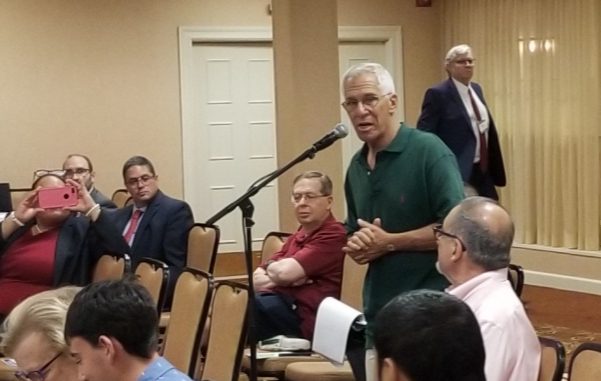
TENAFLY, N.J.—A nearly 70-year-old Port Authority Bus Terminal should be rehabilitated in place to better serve hundreds of thousands of weekly New Jersey bus riders—or better yet, the current Manhattan bus terminal land should be leased and funds generated used to create an ultra-modern transportation system to funnel riders between the two states.
Those were two dominant themes mentioned at the July 10 Port Authority of New York and New Jersey public engagement meeting held July 10 at Tenafly’s Clinton Inn. About 30 people attended the session, with at least 10 from Port Authority staff.
In addition to state Sen. Loretta Weinberg (D-37) and Tenafly Mayor Peter Rustin, another five speakers offered input, including Tenafly Councilman Max Basch, a professional engineer, and several others. A couple speakers spoke twice at the meeting.
The first meeting begins a public outreach process featuring two public meetings each in New Jersey and New York on July 10 and one upcoming Sept. 5.
The July 10 session featured two opportunities for public input at 4 p.m. and 7 p.m.
The bus terminal replacement project is planned to replace the existing terminal and ramps, located in west midtown Manhattan, with a state-of-the-art bus terminal and connecting ramps.
‘Preferred’ by NJ/NY officials
Weinberg—one of New Jersey’s longtime advocates for improving interstate bus operations and the New York City bus terminal—said July 10 that the “build-in-place” option “seems to be preferred by New York and New Jersey public officials.”
Weinberg said three years ago, the expansion of the bus terminal to accommodate a projected increase of 30,000 additional bus commuters “wasn’t even in the Port Authority’s 10-year capital plan.”
She said the build-in-place option, which will add two additional floors to Port Authority, was also preferred by city neighborhood organizations, who opposed purchases of city property and buildings for a bus terminal expansion.
She said the public hearings being held simultaneously in Bergen County and New York City—part of a federally-required “public scoping process”—to gather input on a new bus terminal “were a long time coming.”
Weinberg pointed out due to delays in building a Gateway tunnel, expansion of the bus terminal and PATH system “is critical to expanding trans-Hudson capacity and ensuring that New Jersey commuters share in Manhattan’s projected job growth,” she said.
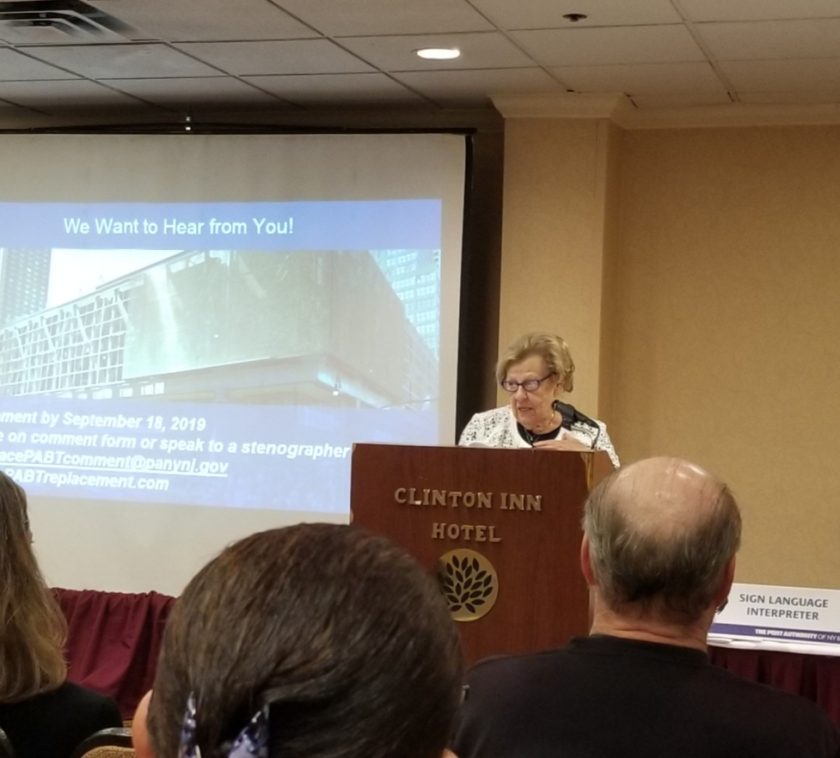
‘Adequate funding’ for rehab
“That’s why we are so focused on ensuring that there is adequate funding to build the increased Port Authority bus terminal capacity in the current Port Authority Capital Plan,” she said, a funding plan that covers projects through 2026. She said she would continue to advocate for funding to upgrade the current terminal’s facilities.
One plan involves a comprehensive rehabilitation of the current terminal building; a second plan involves rehabilitating the existing terminal and using underground space at Javits Center to handle intercity and out-of-state buses while Port Authority remains open to interstate commuter buses.
A third option would place all buses—interstate commuter buses and intercity and out-of-state bus lines—into the Javits Center, potentially making the current terminal available for private development.
2022 construction begins
Should the “build-in-place” option be chosen, construction is anticipated to begin by the end of 2022, said Port Authority spokesperson Scott Ladd, who noted federal environmental approvals were anticipated by 2021.
He said the Federal Transportation Administration was providing regulatory oversight on the terminal replacement project.
Tenafly Mayor Peter Rustin said Weinberg “has been a source of strength and really advocated for commuters” and requested applause for her ongoing efforts. Rustin said improving the current terminal was “the path of least resistance” and called for “desperately needed” improvements to the current facility to assist North Jersey commuters.
“The [private] people that use these terminals are really the ones that should be up there advising the Port Authority as to how to make this new one work,” Rustin suggested.
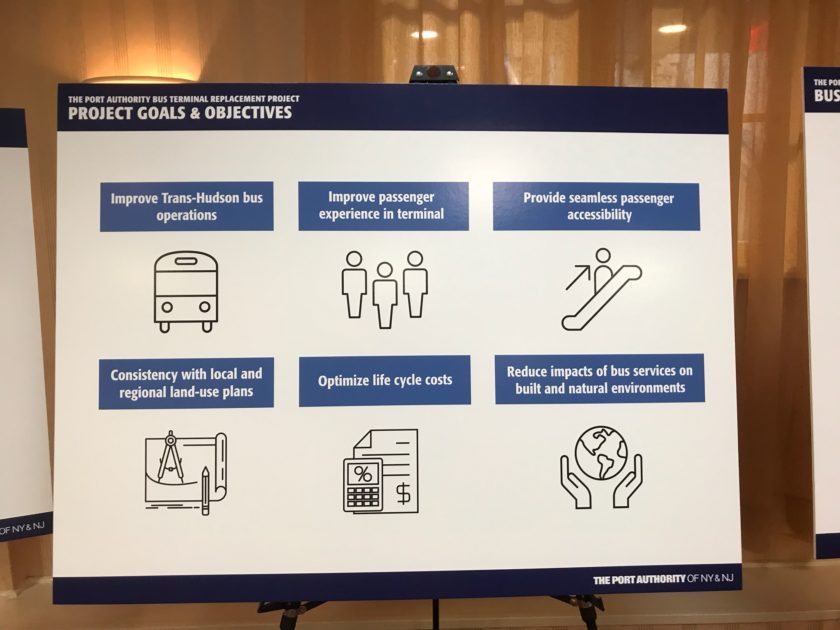
Other alternatives?
Two commenters, Dana Anderssen and Andrew Mikesh, both questioned the Port Authority’s rationale for only considering improvements to an existing transportation system centered on a bus terminal.
Anderssen said he tried to question Port Authority in advance of the July 10 hearing and the agency did not respond.
He suggested a high-tech and modern 24/7 “people-moving system” that connects people to popular locations in both states versus increasing numbers of gas and diesel buses at an expanded bus terminal.
He said Port Authority should sell “the most expensive real estate on this planet” to help pay for an upgrade to a modern transportation system, instead of adding two more floors to Port Authority.
He called 8,000 buses per day going into Port Authority—most coming full and leaving empty—“a crime against nature” and said opportunities exist for bus alternatives including expanding light-rail and a better system for transporting commuters.
“To keep repeating ourselves is just a fool’s errand,” he charged. “It’s ridiculous.”
‘Commuters, not buses’
Andrew Mikesh said he believed the replacement plan should be focused on commuters, not buses.
“Buses are just something that helps with the commuters. Your real charge is enable commuting into New York City,” he said, noting “trying to force-fit more capacity” at an expanded bus terminal would create more traffic “chokepoints” and traffic gridlock.
Mikesh said an alternative suggestion is to lease the current site of Port Authority bus terminal and with funds raised, put a new bus terminal in New Jersey and a new mass transit system to move commuters between the two states.
Mikesh conceded this was obviously a long-term, decadelong project to complete.
Anderssen said a loan based on “monetizing” the Port Authority Bus Terminal site could help fund a new people-moving system, if the Port Authority was interested in an alternative to improving or moving and improving the current bus terminal operations.
Mikesh said later that Port Authority “should think outside the box” and consider eliminating the daily concentration of bus trips.
“This [build-in-place] will only increase the volume of buses no matter where you stage them,” he said.
Port Authority projects a 30 percent increase in bus ridership by 2040, going from 260,000 weekday passenger trips in 2015 to 337,000 in 2040.
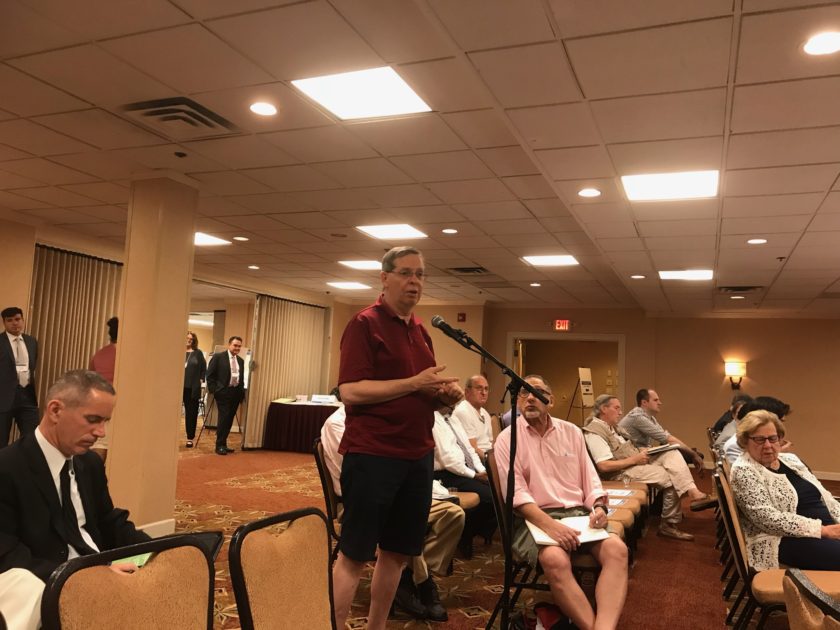
Traffic ‘choke points’
A number of public comments focused on how none of the proposed terminal “replacement plans” addressed what speakers called “traffic choke points” among buses and other vehicles on Manhattan streets and approaching roadways to New York City.
One commenter said more attention needed to be paid to transportation alternatives such as smaller, electric buses.
No details on September 5’s “public scoping” meeting or location have been announced yet.
Also, no cost estimates were provided for any of the three terminal replacement plans.
Before and after each session, about a dozen Port Authority of New York and New Jersey officials—including bus terminal replacement project managers, engineers, and planners—stood near easels holding posters and charts depicting three bus terminal replacement options being considered for the aging, deteriorating terminal built in the 1950s.
The office of U.S. Rep. Bill Pascrell [D-NJ9] issued a statement July 11 on the hearing.
“The Port Authority Bus Terminal is a lifeblood artery for millions in New Jersey and across the region who aren’t the rich and powerful, but the middle and working class who need to take the bus to work and to travel to the Big Apple for a little entertainment,” said Pascrell.
“The crumbling Port Authority Bus Terminal is sadly a living relic of the all-too-often disregarded interests of the commuters who rely on it. I am hopeful today is an important step, the culmination of a shining new terminal in New York that all my constituents can use with ease and pride. We’ve all waited long enough.”
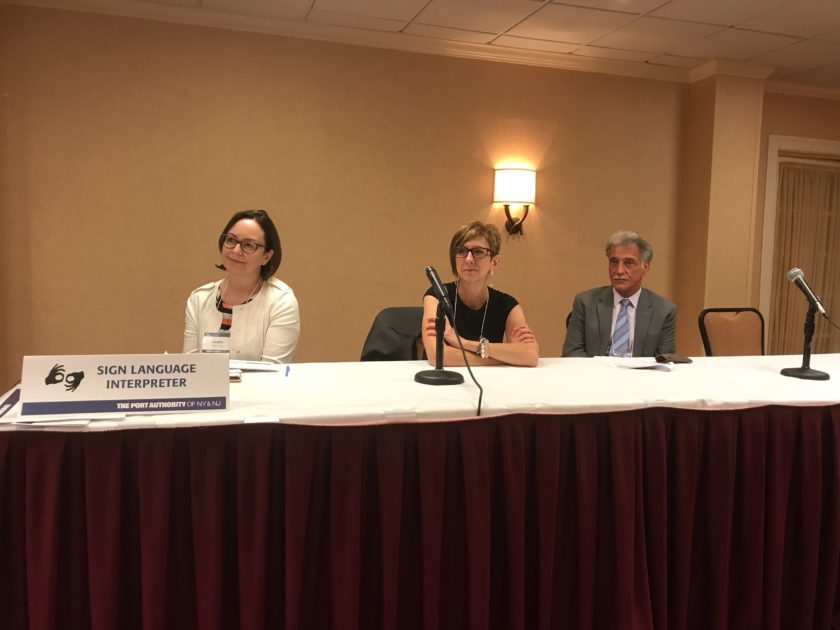
The 181-page “scoping document” released in May by Port Authority is available online at here.
Public comments will be accepted at the next public hearing Sept. 5 and online until Sept. 18. Following completion of the public comment period, Port Authority will issue comments and a Scoping Summary report, submit a final Scoping Document to Federal Transportation Administration, and FTA will initiate a formal environmental review.
